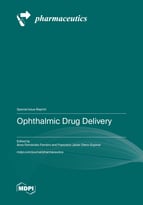Ophthalmic Drug Delivery
A special issue of Pharmaceutics (ISSN 1999-4923). This special issue belongs to the section "Biopharmaceutics".
Deadline for manuscript submissions: closed (10 July 2020) | Viewed by 72990
Special Issue Editors
Interests: ocular drug delivery
Special Issues, Collections and Topics in MDPI journals
Interests: ocular drug delivery; ocular pharmacokinetic; drug development; pharmacogenetics; clinical and translational research
Special Issues, Collections and Topics in MDPI journals
Special Issue Information
Dear Colleagues,
Research in ophthalmic drug delivery has developed significant advances in the last years, and efforts have been made to develop more effective topical formulations to increase the drug bioavailability, efficiency, and safety. Drug delivery to the posterior segment of the eye remains a great challenge in the pharmaceutical industry due to the complexity and particularity of the anatomy and physiology of the eye. Some advances have been made with the purpose of maintaining constant drug levels in the site of action. The anatomical ocular barriers have a great impact on drug pharmacokinetics and, subsequently, on the pharmacological effect.
Despite the increasing interest in efficiently reaching the posterior segment of the eye with reduced adverse effects, there is still a need to expand knowledge of ocular pharmacokinetics that allows the development of safer and more innovative drug delivery systems. These novel approaches may greatly help to improve the lives of patients with ocular pathologies.
In this Special Issue, our goal is to highlight papers describing the advances in ophthalmic drug delivery systems for topical and specialized ocular administration.
Prof. Dr. Francisco Javier Otero-Espinar
Dr. Anxo Fernández Ferreiro
Guest Editors
Manuscript Submission Information
Manuscripts should be submitted online at www.mdpi.com by registering and logging in to this website. Once you are registered, click here to go to the submission form. Manuscripts can be submitted until the deadline. All submissions that pass pre-check are peer-reviewed. Accepted papers will be published continuously in the journal (as soon as accepted) and will be listed together on the special issue website. Research articles, review articles as well as short communications are invited. For planned papers, a title and short abstract (about 100 words) can be sent to the Editorial Office for announcement on this website.
Submitted manuscripts should not have been published previously, nor be under consideration for publication elsewhere (except conference proceedings papers). All manuscripts are thoroughly refereed through a single-blind peer-review process. A guide for authors and other relevant information for submission of manuscripts is available on the Instructions for Authors page. Pharmaceutics is an international peer-reviewed open access monthly journal published by MDPI.
Please visit the Instructions for Authors page before submitting a manuscript. The Article Processing Charge (APC) for publication in this open access journal is 2900 CHF (Swiss Francs). Submitted papers should be well formatted and use good English. Authors may use MDPI's English editing service prior to publication or during author revisions.
Keywords
- ocular pharmacokinetics
- ocular drug delivery systems
- ocular routs of drug administration
- intravitreal administration
- topical administration
Related Special Issues
- Ophthalmic Drug Delivery, 2nd Edition in Pharmaceutics (18 articles)
- Ophthalmic Drug Delivery, 3rd Edition in Pharmaceutics (3 articles)








